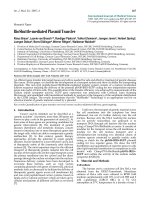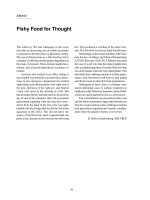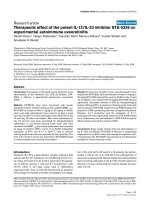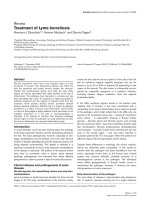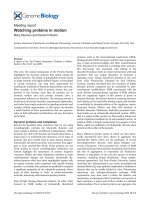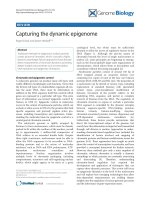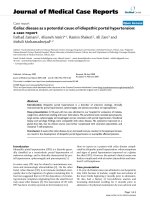Báo cáo y học: "rchaea at St Andrews" pot
Bạn đang xem bản rút gọn của tài liệu. Xem và tải ngay bản đầy đủ của tài liệu tại đây (53.22 KB, 3 trang )
Genome
BBiioollooggyy
2008,
99::
321
Meeting report
AArrcchhaaeeaa aatt SStt AAnnddrreewwss
Andrew T Large and Peter A Lund
Address: School of Biosciences, University of Birmingham, Birmingham B15 2TT, UK.
Correspondence: Peter A Lund. Email:
Published: 30 September 2008
Genome
BBiioollooggyy
2008,
99::
321 (doi:10.1186/gb-2008-9-9-321)
The electronic version of this article is the complete one and can be
found online at />© 2008 BioMed Central Ltd
A report of the Biochemical Society meeting 'The Molecular
Biology of Archaea', St Andrews, UK, 19-21 August 2008.
The closest that most biologists ever come to working with
archaea is probably when they use a DNA polymerase such
as Pfu, from the hyperthermophilic archaeon Pyrococcus
furiosus, in PCR. Misconceptions about archaea still
abound: everyone now appreciates that they are not bacteria,
but they are often still thought of as curious organisms that
live only in extreme environments, inaccessible to genetic
study and of interest only to those at the fringes of biological
research. The extent to which these views are outdated was
abundantly illustrated at a recent meeting on the molecular
biology of archaea at St Andrews in Scotland. In fact,
archaea are widely distributed in all environments and are of
considerable geochemical importance. For some model
species an impressive genetic toolkit is available, which in
combination with the 50 or so completely sequenced and
annotated archaeal genomes, is leading to significant
advances in the understanding of archaeal gene function.
And because of their relatedness to eukaryotes, study of
many core biological processes in archaea can illuminate,
often at a structural level, similar processes in their more
complex eukaryotic cousins.
DDNNAA rreepplliiccaattiioonn,, rreeccoommbbiinnaattiioonn,, aanndd rreeppaaiirr
One of the great attractions of working on archaea is that
they provide stripped-down forms of processes that occur in
eukaryotes. Dale Wigley (Clare Hall Laboratories, Cancer
Research UK, South Mimms, UK) discussed one such
example, the replication origin binding protein (ORC) of
Aeropyrus pernix, which could provide insight into the
conserved elements of eukaryotic origin recognition. At the
replication origin of the A. pernix chromosome are four ORB
elements, short conserved repeats arranged in pairs on
either side of a AT-rich region named a duplex unwinding
element. Wigley's group has shown that only one of the two
ORC proteins (ORC1) in A. pernix binds at the origin, where
it recruits MCM (mini-chromosome maintenance) helicase.
ORC1 is made up of two domains: a Wing-helix domain that
interacts with DNA and MCM helicase, and an AAA+-
ATPase domain, which surprisingly also shows significant
interaction with DNA. The interaction between the AAA+
domain and the DNA causes both a widening of the minor
groove and DNA unwinding. MCM helicase (an ATP-
dependent 3'→5' helicase) was also discussed in a talk by Zvi
Kelman (University of Maryland Biotechnology Institute,
Rockville, USA) who focused on the differing properties of
MCM in Methanothermobacter thermolithotrophicus (Mt)
and Thermoplasma acidophilum (Ta). His group has
found that TaMCM requires a fork-like structure for
efficient helicase activity, whereas MtMCM requires a
3'-overhang. MCM helicase and ATPase activity is
stimulated by cdc6 (an alternative name for the ORC) in
T. acidophilum, but helicase activity is inhibited by cdc6
in M. thermolithotrophicus. Mtcdc6 is also able to dissociate
the MtMCM complex in an ATP-dependent manner.
Another critical protein for DNA replication and repair,
PCNA (named for its eukaryotic homolog, proliferating cell
nuclear antigen), was covered by Malcolm White (St
Andrews University, UK). PCNA acts as a 'molecular
toolbelt', bringing relevant proteins to the DNA at sites such
as stalled replication forks. White has found that Sulfolobus
solfataricus PCNA interacts with repair nucleases (Hjc and
Xpf) that excise the lesions likely to cause stalled replication,
and controls their activity within the cell.
Patrick Forterre (University of Paris-Sud, Paris, France)
introduced a DNA repair complex called KEOPS, which has
recently been described in yeast. The KEOPS complex is an
example of a DNA-processing system that may have been
present in the common ancestor of the Archaea and the
Eukarya, but not the Eubacteria. Forterre described the
identification in archaea of four of the five genes encoding
the proteins of this complex. One of these genes encodes the
universal protein, Kae1, previously misannotated in many
genomes as a peptidase. Forterre and colleagues have in fact
found that it is an AP-lyase that cleaves depurinated DNA. In
some archaea, such as Methanocaldococcus jannaschii, the
genes for the KEOPS kinase protein and Kae1 are fused, and
this fusion protein has been characterized at the structural
level by Forterre and colleagues.
Christa Schleper (University of Vienna, Austria) described
the transcriptional response of S. solfataricus to ultra violet
radiation. Pilus formation was significantly upregulated,
leading to cellular aggregation. She suggested that there may
be exchange of DNA between the aggregated cells,
facilitating the repair of damaged DNA by homologous
recombination. The aggregation is species specific, with cells
of S. tokodaii and S. acidocaldarius forming discrete clumps
in mixed cultures. Dennis Grogan (University of Cincinnati,
USA) described an in vivo assay of homologous
recombination in S. acidocaldarius, using electroporated
donor DNA with a multiply marked pyrE gene. Remarkably,
he has found that recombination occurs between markers
that are extremely close together, and overall it appears
likely that multiple, discontinuous tracts of donor DNA of
varying sizes are responsible for recombination in this
organism.
Reverse gyrase is a DNA topoisomerase that introduces
positive supercoiling, and is unique to thermophilic
organisms, being present in all hyperthermophilic and
some moderately thermophilic archaea, but absent from all
mesophiles. Maria Ciaramella (Institute of Protein
Biochemistry, Naples, Italy) described the reverse gyrase of
S. solfataricus. Its biological function is not known,
although thermal stabilization of DNA at the growth
temperature of hyperthrmophiles could be one role. Her
group has shown that the protein has two domains: an
amino-terminal helicase domain and a carboxyl-terminal
topoisomerase domain which could be expressed
separately and reconstituted into a functional unit.
AArrcchhaaeeaall ttrraannssccrriippttiioonn aanndd tthhee rroolleess ooff RRNNAA
The transcriptional apparatus of archaea has many
similarities to that of eukaryotic cells, but is simpler: there
is only one RNA polymerase, which resembles eukaryotic
RNA polymerase II (Pol II), most of the subunits of which
have clear homologs in the archaeal enzyme. Finn Werner
(University College London, UK) described how his group
has reassembled the 12-subunit archaeal RNA polymerase
complex from individual purified components into a form
that can actively transcribe in vitro, a feat not yet possible
with the eukaryotic RNA Pol II. This, allied with the fact
that a complete structure exists for this RNA polymerase,
is enabling his group to perform a detailed dissection of
subunit roles and structure-function relationships. Werner
noted the example of the F and E subunits, which are
found in archaea and in eukaryotic RNA polymerases (for
example, as RPB7 and RPB4 in RNA Pol II), but are absent
from the bacterial enzyme. These subunits form a complex
that protrudes from the main catalytic core of the RNA
polymerase, and appear to have multiple roles. They
promote closure of the clamp formed by subunits A and B,
which in turn can affect DNA melting and open complex
formation, which in the presence of the transcription factor
TFE can lead to transcription. Interestingly, Werner has
found that they can also stimulate processivity of the RNA
polymerase, an activity that correlates with their ability to
bind RNA. The close evolutionary relationship between
archaeal and eukaryotic RNA polymerases was further
illustrated by Michael Thomm (University of Regensburg,
Germany) who has demonstrated, using a similar in vitro
assembly system, that some eukaryotic subunits can
successfully replace their archaeal homologs. An archaeal
RNA polymerase from P. furiosus lacking subunit P, for
example, fails to form open complexes (where the DNA
strands are partially unwound prior to mRNA synthesis),
but this ability can be restored by the homologous subunit
Rpb12. The archaeal genes cannot rescue gene function in
yeast mutants, however, although some incorporation of
subunits does occur.
Attention was also paid to other aspects of RNA function and
metabolism. Karl-Peter Hopfner (University of Munich,
Germany) discussed his group's recent structural and
biochemical work on the exosome of Archaeoglobus
fulgidus, which is a nine-subunit complex responsible for
RNA degradation. This protein complex binds RNA and
degrades it into trinucleotides, and is remarkably analogous
to the proteasome: RNA has to be threaded through a
narrow pore into a central region of the protein complex
where cleavage takes place. The exosome consists of a
trimeric cap which binds the RNA, sitting atop a hexameric
complex which contains the active site for degradation.
Accessory factors may also be involved in melting the RNA
to enable it to pass into the narrow pore.
Jörg Soppa (University of Frankfurt, Germany) discussed
how the comparison of free mRNA to polysome-bound
mRNA using microarrays can be used to determine
translational efficiency, and showed how such comparisons
in two different haloarchaea indicate that many genes
display significant departures from average translational
efficiency; this is the first such study done in any prokaryote.
He also described work on the occurrence of small RNAs in
archaea, showing that Haloferax volcanii is likely to contain
more than 150 small RNAs, some of which have been shown
to give rise to phenotypes in stress resistance and carbon
metabolism when mutated. Given the current excitement
about novel roles of RNA in eukaryotes, this is surely an area
where more developments are to be expected in archaea.
/>Genome
BBiioollooggyy
2008, Volume 9, Issue 9, Article 321 Large and Lund 321.2
Genome
BBiioollooggyy
2008,
99::
321
The theme of novel roles for RNA was also reflected in talks
on virus and phage resistance. One of the more surprising
findings of the past two years in prokaryote biology has been
the discovery of a system for phage resistance in bacteria -
surprising because, given the long history of phage and
bacterial genetics, one might have expected that all the low-
hanging fruit in this area would have been plucked long ago.
This system, mediated by short repeat DNA elements called
CRISPR sequences and a set of associated genes called cas
(for CRISPR-associated) genes, was reviewed by John van
der Oost (Wageningen University, the Netherlands), who
has reconstituted the system in Escherichia coli to enable
detailed study of its function. In this system, viral sequences
become integrated between the CRISPR repeats, and
processing of the long transcript of the CRISPR region by the
Cas proteins produces small RNAs carrying short phage
sequences that can interfere with the phage infectious cycle.
This has been likened to a primitive form of immunity.
Roger Garrett (Copenhagen University, Denmark) discussed
the occurrence of CRISPR-like sequences in archaeal
genomes, and showed not only how they often match
sequences found in archaeal viruses and plasmids - which
means they might have a regulatory role instead of, or in
addition to, an immune one - but also how evidence exists in
some archaeal viruses of defenses against the CRISPR
system.
Despite the relatedness of archaea and eukarya, and the
extent to which studies on fundamental processes at the
genome level show clear similarities in mechanisms between
the two, it might be assumed that work on archaea is
unlikely to lead to new insights into processes that are
normally considered unique to eukaryotic cells, such as
vesicle formation by membrane invagination. However, it
transpires that vesicle formation may be very much a part of
some archaeal life-cycles: elegant microscopy described by
Reinhard Rachel (University of Regensburg, Germany)
shows that membrane invagination and vesicle formation
may be involved in the cell division of the archaeon
Ignicoccus hospitalis, and that vesicles are also sometimes
seen in the vicinity of the contact sites between this
microorganism and the parasitic archaeon Nanoarchaeum
equitans, which uses I. hospitalis as a host. These
observations served as a reminder that, even in a post-
genomic world, there is still no substitute for actually
looking at cells. The hunt is now on for the genetic
determinants of this process.
Reverse genetics is of course a key part of functional
genomics. Various tools for this are now well advanced in
several archaea, notably halophiles and some methanogens.
The meeting heard reports from Qunxin She (University of
Copenhagen, Denmark) and Sonja Albers (University of
Gronigen, the Netherlands) on further development of a
number of reverse genetic tools, including expression and
shuttle vectors and new methods for making knockouts, for
different species of Sulfolobus. Importantly, these include S.
sulfotaricus, widely used as a model organism but hitherto
not very genetically tractable. It is becoming more routine to
include genetic analysis alongside biochemical studies, and
the ability to do complementation assays with site directed
mutants means that the linkage between structural,
biochemical and genetic studies is now in place for many
archaeal species. All this promises well for the future and the
ability of archaea to give structural and evolutionary insights
into basic and universal cellular processes.
/>Genome
BBiioollooggyy
2008, Volume 9, Issue 9, Article 321 Large and Lund 321.3
Genome
BBiioollooggyy
2008,
99::
321
